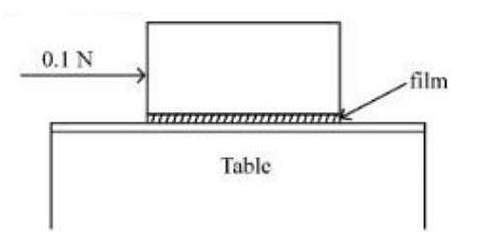The CGS unit of coefficient of viscosity is
- $\ce{N \, s \, m^{-2}}$
- $\ce{g \, cm^{-1}s^{-1}}$
- $\ce{cm^{-1} s^{-1}}$
- $\ce{kg \, s^{-2}}$
The Correct Option is B
Solution and Explanation
Top Questions on Viscosity
- A metal block of base area \(0.20 \,m^2\) is placed on a table, as shown in figure. A liquid film of thickness \(0.25\, mm\) is inserted between the block and the table. The block is pushed by a horizontal force of 0.1 N and moves with a constant speed. If the viscosity of the liquid is \(5.0×10^{−3}Pl\), the speed of block is ________ \(×10^{−3}m/s\)

- JEE Main - 2023
- Physics
- Viscosity
- An air bubble of diameter 6 mm rises steadily through a solution of density 1750kg / m3 at the rate of 0.35 cm/s. The co-efficient of viscosity of the solution (neglect density of air) is ____Pas (given, g = 10ms-2)
- JEE Main - 2023
- Physics
- Viscosity
- The sensitiveness of a bubble tube in a level would decrease if.
- Given below are two statements: one is labelled as Assertion A and the other is labelled as Reason R.
Assertion A: As temperature increases, viscosity of air decreases.
Reason R: As the temperature increases, activity of air molecule increases.
In the light of the above statements, choose the correct answer from the options given below - Unit of kinematic viscosity is.
Questions Asked in TS EAMCET exam
The number of significant figures in the measurement of a length 0.079000 m is:
- TS EAMCET - 2023
- Units and measurement
The roots of the equation x4 + x3 - 4x2 + x + 1 = 0 are diminished by h so that the transformed equation does not contain x2 term. If the values of such h are α and β, then 12(α - β)2 =
- TS EAMCET - 2023
- Quadratic Equations
The number of electrons with (n+1) values equal to 3,4 and 5 in an element with atomic number (z) 24 are respectively (n = principal quantum number and l = azimuthal quantum number)
- TS EAMCET - 2023
- atom structure models
Two convex lenses of focal lengths 20 cm and 30 cm are placed in contact with each other co-axially. The focal length of the combination is:
- TS EAMCET - 2023
- Ray optics and optical instruments
- If the ratio of densities of two substances is 5:6 and the ratio of their specific heat capacities is 3:5, then the ratio of heat energies required per unit volume so that the two substances can have same temperature rise is:
- TS EAMCET - 2023
- Thermodynamics
Concepts Used:
Viscosity
Viscosity is a measure of a fluid’s resistance to flow. The SI unit of viscosity is poiseiulle (PI). Its other units are newton-second per square metre (N s m-2) or pascal-second (Pa s.) The dimensional formula of viscosity is [ML-1T-1].
Viscosity: Formula
Viscosity is measured in terms of a ratio of shearing stress to the velocity gradient in a fluid. If a sphere is dropped into a fluid, the viscosity can be determined using the following formula:
η = [2ga2(Δρ)] / 9v
Where ∆ρ is the density difference between fluid and sphere tested, a is the radius of the sphere, g is the acceleration due to gravity and v is the velocity of the sphere.
Viscosity: Types
- Dynamic viscosity: When the viscosity is measured directly by measuring force. It is defined as the ratio of shear stress to the shear strain of the motion. Dynamic viscosity is used to calculate the rate of flow in liquid.
- Kinematic viscosity: There is no force involved. It can be referred to as the ratio between the dynamic viscosity and density of the fluid. It can be computed by dividing the dynamic viscosity of the fluid with fluid mass density.
- Laminar flow: Laminar flow is the type of flow in which the fluid moves smoothly or in a regular path from one layer to the next. Laminar flow occurs in lower velocities.



